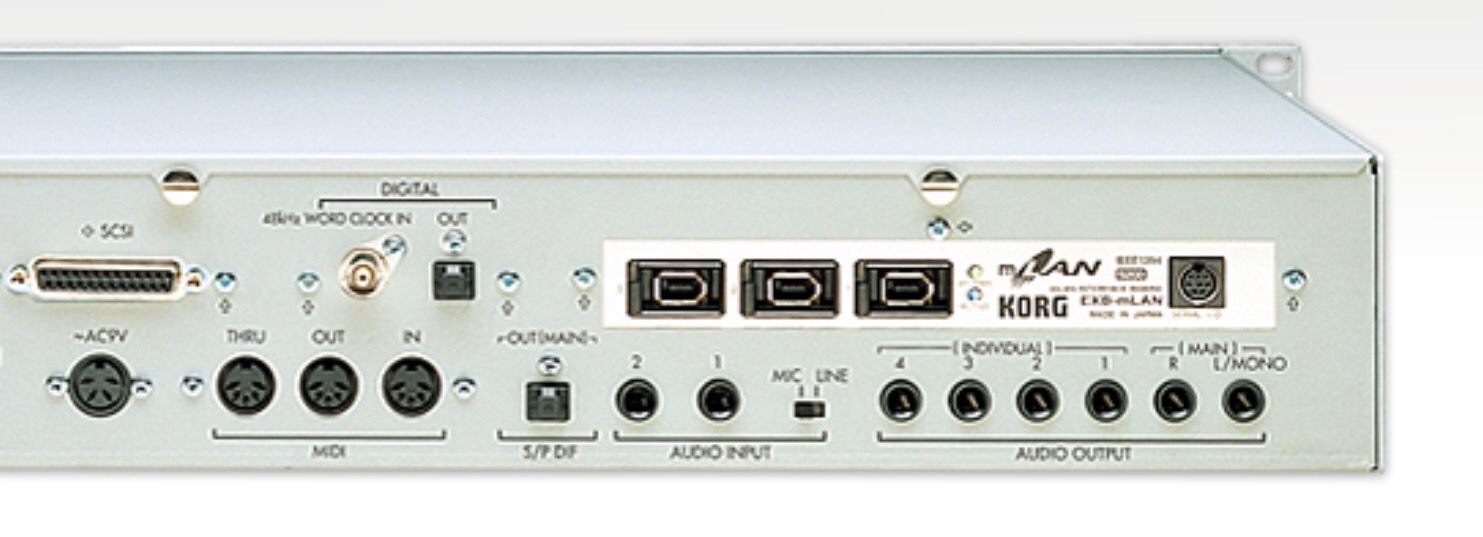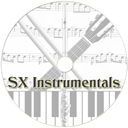Filter on ALL, SYNTH, DRUM, SAMPLER or MISC |
Total list currently 2405 items in 330 Brands |
Korg | Triton Rack |
Description | The TRITON-Rack is a expandable Hi-model sampler that features the HI (Hyper Integrated) synthesis system as its tone generator. Its numerous functions include high-quality preset multisamples/programs/combinations, an effect section, sampling, multis, a dual polyphonic arpeggiator, RPPR, analog two-channel audio input/six-channel audio output, and digital two-channel audio output. By operating the REALTIME CONTROLS [1]–[4] knobs you can control filter or effects to vary the sounds in realtime as you perform. These knobs can also be used to control the gate and velocity of the arpeggiator, and the tempo of the arpeggiator and RPPR. Options such as a MOSS tone generator, PCM/sampling memory expansions, SCSI port, ADAT digital output, and mLAN interface board can be installed to further expand the capabilities of the TRITON-Rack.The TRITON-Rack is a powerful tool for music production or live performance. HI (Hyper Integrated) synthesis system The HI (Hyper Integrated) synthesis system is a PCM tone generator system with full digital signal processing that guarantees pristine sound, and featuring enormous flexibility in musical extensibility, modulation, and effect routing. The synthesis section (filter etc.) provides Alternate Modulation functionality, and the effect section provides Effect Dynamic Modulation functionality. This allows you to freely apply modulation to parameters that affect the pitch, filter, amp, EG, LFO, and effects etc. LFO and delay time etc. can be synchronized to MIDI clock/tempo. You can synchronize sounds or effects to the tempo of the sequencer or the arpeggiator. In Program, the TRITON-Rack provides 1,664 user programs, and 256 programs + 9 drumsets for GM2 compatibility. When the separately sold EXBMOSS option is installed, 128 programs for the Korg MOSS tone generator will also be available. You can use a wide range of editing parameters, effects, and arpeggiator settings to create your own original program, and save it as a user program. For the oscillator of the program, you can select from 425 PCM ROM multisamples, or use samples/multisamples that you recorded in Sampling mode. You can also create drum programs using the 144 user drum kits or the nine GM2-compatible ROM drum kits. User drum kits can be created using the 413 preset drum samples or samples that you recorded in Sampling mode. With the factory settings, 512 user programs suitable for a wide range of styles are preloaded in banks INT-A–INT-D. For these preloaded programs and for the preset programs in banks G, g(1)–g(d), you can use the Audition function to hear the program played using an appropriate riff (phrase). This provides a convenient way to audition or edit programs. The Combination Mode provides 1,664 user combinations. A combination allows you to use layers, splits, or velocity switches etc. to combine up to eight programs together with effects and two arpeggiators, in order to create complex sounds that could not be produced by a program. You can also make settings that include external tone generators. With the factory settings, 512 user combinations suitable for a wide range of styles are preloaded in banks INT-A–INT-D. When one or more separately sold EXB-PCM options are installed (up to eight boards), programs and combinations for the corresponding EXB-PCM can be loaded into user program banks/ user combination banks EXB-A–EXB-H. Rivaling dedicated sampling devices, the TRITONRack features 48 kHz 16-bit linear mono/stereo sampling with a maximum of 96 Mbytes of memory, allowing you to create original sounds from your own audio material. Multi-track musical data can be received from an external sequencer etc. to play the TRITON-Rack as a 16- track MIDI multi-timbral tone generator. The effects, two arpeggiators, and the RPPR function can be used together, allowing the TRITON-Rack to function as a sophisticated sound-generating system with capabilities far beyond those of conventional tone generator modules. In addition to providing conventional arpeggiator functionality, the polyphonic arpeggiator of the TRITON-Rack can respond to the pitches or timing at which you play the keyboard, and produce a diverse range of chords or phrases. This can be used to play a variety of drum phrases, bass phrases, or guitar and keyboard backing riffs. The arpeggiator is also effective for use with subtly moving pads, synth sounds, or sound effects. Five preset arpeggio patterns and 328 user arpeggio patterns are provided. With the factory settings, these contain a wide variety of 200 preloaded user arpeggio patterns. In Combination mode, and Multi mode, the TRITON-Rack provides dual arpeggiators that can simultaneously play two arpeggio patterns. You can apply separate arpeggio patterns to drum and bass programs, or use keyboard splits or velocity to switch between arpeggio patterns for an even more dynamic performance. The TRITON-Rack features a RPPR (Realtime Pattern Play/Recording) function. In Multi mode, this function allows you to assign preset patterns or user patterns (with a specified playback track) to individual notes of the keyboard, and playback or record that pattern in realtime simply by pressing the assigned note. The TRITON-Rack provides 150 preset patterns that can be shared by all multis. In addition, each multi can use 100 user patterns. When you execute the Time Slice function of Sampling mode, a drum phrase or similar sample will be divided into beats, and simultaneously a corresponding pattern will be created and assigned to RPPR. The two channel audio input allows you to record samples in stereo. The MIC/LINE level select switch and the level adjustment knob can be used to support a wide range of external audio sources from mic level to line level. The audio inputs can also be routed through the effects. You can apply effects while sampling, use the TRITON-Rack as a 2-in/6-out effect processor, or use it as a vocoder effect that joins the external source with the TRITON-Rack’s internal sounds. In addition to the L/MONO and R main stereo audio outputs, the TRITON-Rack provides four individual audio outputs, for a total of six channels of audio output. The sound from each oscillator, drum, timbre/track, or insertion effect can be routed freely to any output. SPDIF OUT is standard, for digital (48 kHz)output of the same audio signal as the L/MONO and R main stereo audio outputs. |
| Brand | Korg |
| Model | Triton Rack |
| Device | Synth |
| Type | Rack |
| Engine Type | Digital |
| Engine | PCM |
| Voices (max) | 60 |
| Multitimbral | 16 |
| Oscillators | 2 |
| LFO | 2 Sample & Hold, Saw Up, Square, Triangle |
| Engine Detailed | HI synthesis system; 48 kHz sampling frequency, 32 Mbyte PCM ROM, 425 multi-samples + 413 drum samples |
| Sampler | 16 bit, 48 kHz stereo/mono sampling, 16 MB memory standard, expandable to 64 MB. Maximum of 1,000 multi-samples / 4,000 samples. Up to 128 samples can be assigned to a multi-sample. AIFF, WAVE, AKAI (S1000/S3000) and Trinity sample data can be loaded. (Triton cannot load Trinity format data from TFD-1S, TFD-2S, TFD-3S and TFD-4S , since they use data-compressed data.) |
| FX | 102 (insert effects/ 89 for master effects); Stereo digital multi-effect system - 2 master effects (mono in, stereo out), 5 insert effects (stereo in / out), and 1 master EQ (stereo in / out) simultaneously |
| Memory | 512 programs, 512 combinations, 64 drum programs, GM Level 2 - 256 programs + 9 drum set |
| Sequencer | RPPR (Realtime Pattern Play / Recording): 1 set with 72 patterns available per song. |
| Arpeggiator | Arpeggiator: 5 preset patterns and 232 patterns (approx. 180 preset) |
| Recording | 16 timbres, 16 tracks, 1/192 resolutions, 100 preset / 100 user pattern per a song, 200 songs, 20 cues, 200,000 notes, reads and writes Standard MIDI File (Format 0 and 1) |
| Keys | 0 |
| Key type | N/A |
| Velocity | N/A |
| Aftertouch | N/A |
| Audio | Digital out. |
| Midi | I-O-T |
| Extra info | Total of 8 EXB-PCM expansion sound boards can be installed. EXB-mLan - digital audio and midi transfer, EXB-DI - optical ADAT output with 48kHz word clock in are optional |
| Produced: | 2000 - 2000 |
| Legend: | Obvious | Y: Yes, N: No, N/A: Not Applicable | |
| VCO | Voltage Controlled Oscillator | DCO | Digital Controlled Oscillator |
| LFO | Low Frequency Oscillator | Sub | Sub Oscillator |
| VCF | Voltage Controlled Filter | VCA | Voltage Controlled Amplifier |
| Velocity | As with a piano, the harder you hit a key, the louder the sound, unlike most organs which always produce the same loudness no matter how hard you hit a key. | Aftertouch | Pressing a key after you activated it. Channel Aftertouch, no matter which key, it will send a Channel message. Poly Aftertouch, sends the pressure per key instead of the whole channel. |
| Values for OSC, LFO, Filter, Envelope are per voice unless stated otherwise. | |||




